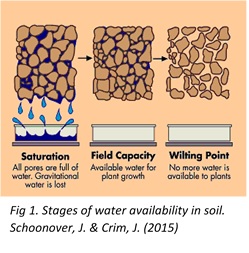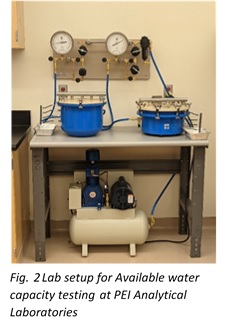Understanding Available Water Capacity: An Important Part of your Soil Health Testing Regime
Available water capacity (AWC), is defined as the amount of water that is available to the plant roots from the soil. Climate change and seasonal precipitation variability is increasingly providing moisture challenges in crop production on PEI. Understanding a soil’s ability to retain water, so that it is available for plant uptake, is an important consideration for crop management.
Background
Once a soil is completely saturated with water (for instance after a soaking rain), only a portion of that water is retained in the soil profile, and only some of that retained water is accessible to plant roots. As the soil becomes saturated, gravity begins to pull the excess water down further into the soil where roots cannot reach. The soil will continue to lose that excess water until coming to an equilibrium, known as field capacity. Conversely, as a soil dries there comes a point where the only remaining moisture is held so tightly by clay and organic matter that plant roots cannot access it. This is known as permanent wilting point. Between these two points, water is trapped in small pores throughout the soil, known as capillary water. This portion of water is what plant roots can take up and is what is measured through the AWC analysis.
Every soil’s field capacity and wilting point are different, and influenced by many factors including soil texture, organic  matter levels, aggregation, and bulk density. Available water capacity is measured in the lab using a pressure chamber technique (fig. 2) where saturated soil samples are exposed to pressure forces that replicate a standard field condition at field capacity (0.1 Bar) and wilting point (15 Bar). The volumes of water at each stage are measured, and the difference is calculated as total available water capacity.
matter levels, aggregation, and bulk density. Available water capacity is measured in the lab using a pressure chamber technique (fig. 2) where saturated soil samples are exposed to pressure forces that replicate a standard field condition at field capacity (0.1 Bar) and wilting point (15 Bar). The volumes of water at each stage are measured, and the difference is calculated as total available water capacity.
PEI soils are primarily a sandy loam texture. The high percentage of sand allows water to percolate away from roots at a higher rate than finer clay/silt-based soils, resulting in a narrower window of available water. Best management practices that promote stronger microbiology (for instance increasing organic amendments, reducing tillage, and extending rotations) will all add to increasing AWC over time, as healthy and biologically active soil will generally have a more porous, “sponge-like” consistency. A crop’s ability to access available water is dependent not only on the soil’s water holding capacity but also on the root’s ability to access moisture in the soil. Deeper, more interwoven rooting systems will access more water through increased surface area and ability to scavenge for water.
For more information, contact:
PEI Analytical Laboratories
Phone: 902-620-3300
